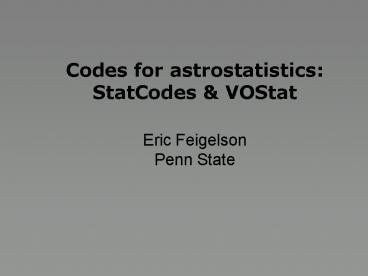Codes for astrostatistics: StatCodes - PowerPoint PPT Presentation
1 / 9
Title:
Codes for astrostatistics: StatCodes
Description:
Title: Codes for astrostatistics: StatCodes & VOStat Eric Feigelson Penn State Created Date: 2/27/2004 1:12:00 AM Document presentation format – PowerPoint PPT presentation
Number of Views:50
Avg rating:3.0/5.0
Title: Codes for astrostatistics: StatCodes
1
Codes for astrostatisticsStatCodes
VOStatEric FeigelsonPenn State
2
Vast range of statistical problemsin modern
astronomy
- Poisson processes point processes, time series
analysis - Image analysis MLE deconvolution, adaptive
smoothing, wavelet analyses - Multivariate analysis classification (w/ meas
errors) - Survival analysis (censoring truncation w/ meas
errors) - Parametric models Model selection, non-linear
regression - Non-parametric methods
- Confidence limits bootstrap resampling
- Prior knowledge Bayesian inference
- (see talk at PhysStat 2003 conference)
3
The problem
- Astronomers are insufficiently trained in
- modern applied statistics ..
- but even if they knew what to do, they
- inadequate access to computer codes.
4
- Astronomers never use large commercial
statistical packages like SAS, SPSS, Statistica - Some astronomers sometimes use UNIX-based
command-line systems like MatLab or S-Plus. - Astronomers like mini-codes in Numerical Recipes
often write their own codes. Many like IDL
which has simple statistics. - NASA/NSF observatories produce huge data analysis
codes (IRAF, AIPS, CIAO, ) which by policy avoid
proprietary codes - A few specialized stand-along astrostat codes
written under NASA funding ROSTAT, ASURV,
SLOPES, StatPy - Altogether this is a very bad situation
- vast statistical needs
- with very inadequate codes
5
The rise of the Virtual Observatory
- Vast collections of calibrated data (images,
spectra, time series), extracted catalogs
(rowssources, columnsproperties), and source
bibliographies emerged during the 1990s. - NASA Science Archive Centers (MAST, HEASARC,
IRSA, LAMDA), bibliographic databases (ADS,
SIMBAD, NED), more are being transformed into a
federated (though still distributed
heterogeneous) system. XML metadata (VOTable),
SOAP protocols, for data mining extraction. - but originally no plan for visualization
- statistical analysis of extracted datasets
6
StatCodes A partial solution
- In late-1990s, the Penn State group created a Web
metasite with annotated links to 200 open source
packages codes of utility to astronomers. - Quite successful 50-100 hits/day for 7 years.
- Multivariate time series methods most popular.
- But the collection of on-line codes was
- very inhomogeneous and incomplete
7
RFinally a broad public-domain statistical
software system emerges
- Based on the successful commercial UNIX-based
- S/S-Plus, R has an interactive command-line feel
- (like IDL), flexible data I/O, acceptable
graphics, - integration to C/Fortran/Python/, and quite a
lot of - sophisticated statistical methods.
- Core R 2000-page manual with 200
functionalities, some very complex advanced - CRAN 300 add-on packages, dozens useful to
astronomers. Some are themselves full systems.
8
VOStat A Web service
- Web form interface providing simple statistical R
functions with VOTable inputs - Same R functions provided through a more
sophisticated Java-based grid-computing mode.
Heavy data
Dispersed VO
Heavy statistical computation
Requests
User
VOStat server
Answers
data bases
9
VOStat may be a big improvement but
- Generic Web-based services are inherently
inflexible limited. VOStat may serve to entice
the astronomer to download R perform the real
analysis at home. - Astronomers need training in advanced methods
before using them with R. Penn State has just
created a Center for Astrostatistics to develop
curriculum, conduct tutorials, provide template R
code, etc. - R/CRAN does not serve huge VO datasets or some
special astrostat needs. New methodological/code
development underway (CMU, Cornell, PSU, UCIrv,)































